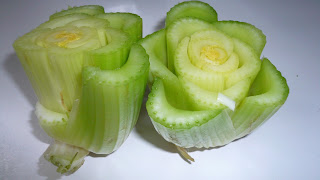I attempted to grow celery last year and was unsuccessful. I hadn't done my research. But after talking to a fellow gardener, who grows celery with great success, I was encouraged to try it again. There is a lot of information out there on this topic. I tried to simply it the best I could.
If you are starting celery from seed, start indoors 10-12 weeks before the last spring frost. Celery is a slow grower, with a long maturation period (16 weeks). Soak celery seeds in warm water (4+ hours), to speed up germination. Place 2 or 3 seeds to a pot and cover lightly with starter soil. Celery seeds needs light and constant moisture, and takes about 7 to 14 days to germinate. Plan to transplant celery into the garden 1 to 2 weeks before the last frost date, when plants are about 4 to 6 inches tall. Harden off 7 to 10 days (and there are 5 to 6 leaves on each plant), prior to transplanting. Plant in rich, well composted soil with a pH of 5.8 to 6.8. Keep soil moist throughout the growing season. If temperatures fall below 50 degrees for an extended period of time, celery may bolt (this is where a hoop house would help). However, celery can handle a lite frost. Plant celery where it gets about 6 hours of sun daily, but avoid the hottest part of your garden (or provide a shade cloth). Use fish emulsion or other organic liquid fertilizer to encourage vigorous growth.
Non-organic, commercially grown celery, ranks high on the list of vegetables contaminated with chemical pesticides. It may be worth taking on this gardening challenge once more!
A (very) Simple Celery Soup Recipe
2 T olive oil
2 T of butter
4 cloves of garlic sliced
1 medium onion chopped
1 baking potatoes chopped
1-2 pounds of celery, cut into 1/2 inch pieces
sea salt (to taste)
pepper (to taste)
seasonings such as thyme or basil (to taste)
juice of 1 lemon
half-and-half or cream 1/4 to 1/2 cup
Heat olive oil in a heavy- bottom soup pot on medium heat. Add onions, garlic,celery, salt, pepper and seasonings and cook for about 5-10 minutes, or until celery is soft. Add 6 cups of water, potato and butter. Bring to a boil. Reduce heat and simmer for about 20 minutes.The celery and potatoes should be very tender. Carefully, puree in batches in a blender. (Remove center from lid and cover with a folded dish towel, allowing steam to escape). Return to pot and add lemon juice and additional seasonings as needed. Add cream before serving.
Starting Celery from Stalks
I had heard that you could grow celery from the stalks, so I thought I would give it a try.
 |
| Cut celery about 1-2" from its base. |
 |
| Place cut side up in water for about a week, changing water every couple of days. Place near a sunny window. |
 |
| After about a week, I planted them in large peat pots using potting soil. The centers are starting to grow. |
 |
| 2 weeks growth. I used a little fish fertilizer on them today. |
Check back for updates!












